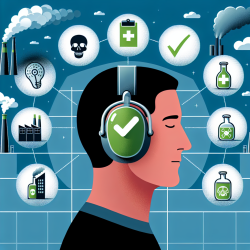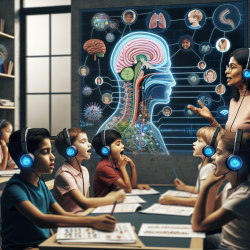Understanding the Impact of Environmental Exposures on Hearing Loss
As a practitioner in the field of special education or audiology, understanding the environmental factors contributing to hearing loss is crucial. The research article titled "Environmental Exposures and Hearing Loss" provides valuable insights into how pollutants like noise, heavy metals, and chemicals can affect auditory health. This blog will highlight key findings from the study and suggest practical ways to integrate these insights into your practice.
The Pervasive Problem of Noise Pollution
Noise pollution is a common environmental hazard that can lead to noise-induced hearing loss. This type of hearing loss occurs when individuals are exposed to loud noises over extended periods. The research indicates that even moderate noise levels can cause temporary hearing threshold shifts, while prolonged exposure can lead to permanent damage.
To mitigate these effects, practitioners can:
- Advocate for noise-reduction measures in schools, such as soundproofing and the use of quieter equipment.
- Educate students and staff about the importance of using hearing protection in noisy environments.
- Encourage regular hearing screenings to detect early signs of hearing loss.
The Hidden Dangers of Heavy Metals
Heavy metals like lead and cadmium are environmental pollutants that can cause auditory dysfunction. These metals are often found in industrial areas and can accumulate in the body over time, leading to irreversible hearing loss.
Practitioners can take the following steps to address this issue:
- Promote awareness about the sources of heavy metal exposure, such as old paint, batteries, and industrial emissions.
- Collaborate with local health departments to monitor and reduce environmental exposure in communities.
- Implement educational programs to teach children and families about the risks of heavy metal exposure and how to avoid them.
Ototoxic Chemicals: A Silent Threat
Exposure to ototoxic chemicals, including organic solvents like toluene and xylene, can impair auditory perception. These chemicals are often found in industrial settings and consumer products.
To protect against these chemicals, practitioners can:
- Advocate for safer alternatives to ototoxic chemicals in schools and workplaces.
- Educate staff and students about the risks of exposure and the importance of using protective equipment.
- Encourage policies that limit the use of ototoxic chemicals in school environments.
Encouraging Further Research and Intervention
The research highlights the need for further studies on the synergistic effects of combined exposures to environmental ototraumatic agents. Understanding these interactions is essential for developing effective prevention and treatment strategies.
Practitioners can contribute to this effort by:
- Participating in or supporting research initiatives focused on environmental health and hearing loss.
- Staying informed about the latest findings through conferences, publications, and webinars.
- Collaborating with researchers and policymakers to advocate for updated regulatory standards that consider combined exposures.
By implementing these strategies, practitioners can play a vital role in protecting auditory health and improving the quality of life for individuals at risk of hearing loss.
To read the original research paper, please follow this link: Environmental Exposures and Hearing Loss.










